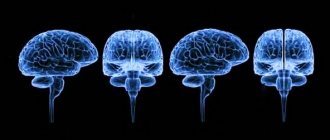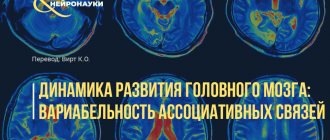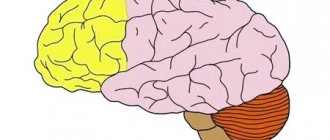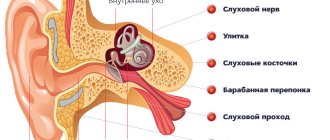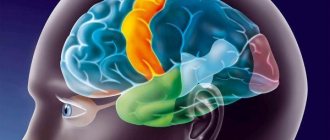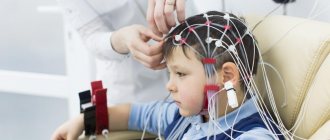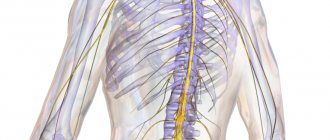| Insula, insular cortex | |
| Right hemisphere insula | |
| Coronal section of the brain, insula marked top right | |
| Part | Cerebral cortex |
| Catalogs | |
| |
| Media files on Wikimedia Commons | |
Ostrovkovaya
, or
central lobe
(lat. lobus insularis), or
insula
(lat. insula), in a number of sources -
insular cortex
(lat. cortex insularis) - part of the cerebral cortex located in the depths of the lateral sulcus. The insular cortex is considered responsible for the formation of consciousness and also plays a role in the formation of emotions and the maintenance of homeostasis.
Content
- 1 Anatomy 1.1 Pathways
- 1.2 Cytoarchitecture
- 1.3 Brodmann fields
- 3.1 Processing of multimodal sensory information
- 4.1 Progressive expressive aphasia
Anatomy
The central insular groove (lat. sulcus centralis insulae) divides the lobe into two parts: the larger anterior and smaller posterior. A large area of cortex covering the insula superiorly and laterally forms the operculum (lat. pars opercularis) and is formed from parts of the adjacent frontal, temporal and parietal lobes. The anterior part of the central lobe is divided into three or four short convolutions, and the posterior part is formed by long convolutions.
Pathways
The central lobe communicates through the white matter tracts with the nuclei of the thalamus, located ventrally at the base, and the central nucleus of the amygdala.
Studies in rhesus monkeys have established bidirectional connections between the insula and the small nuclei of the amygdala. Its posterior sections predominantly communicate with the central and dorsolateral part of the amygdala. The anterior sections of the insula contain the anterior, medial, cortical and other nuclei of the amygdala.
The posterior part of the insula is interconnected with the secondary somatosensory cortex. Thus, it receives signals from the ventral basal ganglia of the thalamus, which receive afferent information from the spinothalamic tract. This area also receives signals from the medial ventral nucleus of the thalamus, specialized in transmitting homeostatic information - pain, tactile, temperature sensitivity, local oxygen status, irritation and others.
Neuroimaging studies [ what?
] using diffusion MRI showed that the anterior part of the insula is interconnected with areas in the temporal and occipital lobes, the opercular and fronto-orbital cortex, and the triangular and tegmental parts of the frontal lobe. The same study found differences in anatomical connectivity patterns between the left and right hemispheres.
Cytoarchitecture
In the insular cortex, areas with different cellular structures or cytoarchitecture were found, in particular, granular cell in the posterior part and agranular cell in the anterior. John Allman and his colleagues showed that the anterior cortex contains a population of spindle neurons. They are also called von Economo neurons.
Paul Brodmann
According to the classification of cytoarchitectonic Brodmann areas of the cortex, the insular region of the cerebral cortex contains Brodmann areas 13, 14, 16, as well as areas 44 and 55.
Posterior, including the cerebellum and pons
The hindbrain itself consists of the pons and cerebellum, which are part of the rhomboid region. The hindbrain cavity communicates with the medulla oblongata (fourth ventricle). The pons is located under the cerebellum and contains a large amount of nerve fiber, forming descending tracts that transmit information from the spinal cord to various parts of the brain structures. The bridge diagram is presented in the form of a ridge with a depression (basilar groove).
The third section of the central organ regulates the vestibular apparatus and coordination of movements. These functions are provided by the cerebellum, which is also involved in the adaptation of the motor center in various disorders. The cerebellum is often called the small brain - this is due to its visual similarity to the main organ. The small brain is located in the cranial fossa and is protected by a dura mater.
Anatomical structure:
- Right hemisphere;
- Left hemisphere;
- Worm;
- Brain body.
The cerebellar hemispheres have a convex surface (lower), the upper part is flat. On the posterior surface of the edges there is a gap, the anterior edge with pronounced grooves. The lobules of the cerebellum on the surface are formed by small grooves and leaves, covered with cortex on top.
The lobules are connected to each other by a worm, from the large brain, the small one is separated by a gap into which the process of the dura mater enters (the tentorium of the cerebellum - stretched over the cranial fossa).
The peduncles extend from the cerebellum:
- Lower - to the medulla oblongata (nerve fibers coming from the spinal cord pass through the lower legs);
- Middle - to the bridge;
- Upper - to the midbrain.
The outside of the brain is covered by a layer of gray matter, under which there are bundles of axons. If this area is damaged or there is an abnormality in development, the muscles become atonic, a staggering gait and tremors of the limbs appear. Changes in handwriting are also noted.
Damage to the pyramidal tracts located in the pons leads to spastic paresis - damage to this part of the brain is associated with impaired facial expressions.
Functions
Processing multimodal sensory information
Functional imaging studies show activation of the insular cortex throughout the performance of audio-visual integration tasks.
Interoceptive self-awareness
There is evidence that in addition to its basic function, the insula may play a role in some higher mental functions. Functional imaging studies have shown that activity in the right anterior insula correlates with a person's ability to sense their own heartbeat or empathize with the pain of others. It is believed that these functions do not differ from the basic functions of the insula, since they arise as a result of the insula's perception of homeostatic information from the thalamus. Thus, the insula is involved in the perception of heat and cold (without pain) on the skin. This includes a feeling of fullness in the stomach and bladder.
Insula activity has been found to be involved in blood pressure control, particularly during and after exercise; In addition, its activity depends on the amount of conscious effort.
The central lobe stands out as the center for evaluating the sensations that arise, which is also expressed in empathy, for example, when a person experiences painful sensations when looking at someone else's pain.
One tomography study showed that the sensation of shortness of breath is processed in the insula and amygdala.
Cortical processing of the vestibular sensation (balance) also involves the central lobe cortex, so with minor damage to the anterior insula the patient may experience dizziness.
Other interoceptive perceptions that are processed in the insular cortex are passive listening to music, laughing and crying, compassion and empathy, and language.
Motor control
The work of the central lobe cortex is involved in hand and eye movements, swallowing, gastric motility and language articulation. Studies of the insular cortex during conversation have shown its connection with the ability to speak for a long time and complex phrases. The insular cortex is also involved in motor learning and has been identified as playing a significant role in recovery and restoration of motor function after stroke.
Social emotions
In the central lobe, processes of processing sensations of disgust take place, both to smells, to the sight of dirt and mutilation - even imaginary ones. In the social aspect, the insular cortex is involved in processing information about violation of generally accepted norms of behavior, emotional processes, empathy and orgasm. The activity of the lobe was discovered when making social decisions made as a result of passing various tests.
Insula
The insular, or central lobe, or insula, in a number of sources - the insular cortex - is a part of the cerebral cortex located in the depths of the lateral sulcus. The insular cortex is considered responsible for the formation of consciousness and also plays a role in the formation of emotions and the maintenance of homeostasis.
Medicine Sections of medicine Clinical sections of medicine Neurology
1. Anatomy
Central insular sulcus lat. The sulcus centralis insulae divides the lobe into two parts: a large anterior one and a smaller posterior one. A large area of cortex covering the insula superiorly and laterally forms the operculum of the lat. pars opercularis and are formed from parts of the adjacent frontal, temporal and parietal lobes. The anterior part of the central lobe is divided into three or four short convolutions, and the posterior part is formed by long convolutions.
1.1. Anatomy
Cytoarchitecture
In the insular cortex, areas with different cellular structures or cytoarchitectonics were found, in particular, granular cell in the posterior part and agranular cell in the anterior.
John Allman and his colleagues showed that the anterior cortex contains a population of spindle neurons. They are also called von Economo neurons. 1.2. Anatomy
Brodmann's fields
According to the classification of cytoarchitectonic Brodmann's fields of the cortex, the insular region of the cerebral cortex contains Brodmann's fields 13, 14, 16, as well as fields 44 and 55.
2. Development
Some researchers believe that the insular cortex develops from a separate part of the telencephalon lat. telencephalon. Other sources consider it to be a derivative of the temporal lobe. In most studies, the insular cortex is considered a relatively old structure.
3. Functions
Processing of Multimodal Sensory Information Functional imaging studies show activation of the insular cortex throughout the performance of audio-visual integration tasks.
3.1. Functions
Processing of Multimodal Sensory Information
Functional imaging studies show activation of the insular cortex throughout the performance of audio-visual integration tasks.
3.2. Functions
Interoceptive Self-Awareness
There is evidence that in addition to its basic function, the insula may play a role in some higher mental functions.
Functional imaging studies have shown that activity in the right anterior insula correlates with a person's ability to sense their own heartbeat or empathize with the pain of others. It is believed that these functions do not differ from the basic functions of the insula, since they arise as a result of the insula's perception of homeostatic information from the thalamus. Thus, the insula is involved in the perception of heat and cold without pain on the skin. This includes a feeling of fullness in the stomach and bladder. Insula activity has been found to be involved in blood pressure control, particularly during and after exercise; In addition, its activity depends on the amount of conscious effort. The central lobe stands out as the center for evaluating the sensations that arise, which is also expressed in empathy, for example, when a person experiences painful sensations when looking at someone else's pain. One tomography study showed that the sensation of shortness of breath is processed in the insula and amygdala. Cortical processing of the vestibular sense of balance also involves the central lobe cortex, so with minor damage to the anterior insula the patient may experience dizziness. Other interoceptive perceptions that are processed in the insular cortex are passive listening to music, laughing and crying, compassion and empathy, and language. 3.3. Functions
Social emotions
In the central lobe, processes of processing sensations of disgust take place, both to smells, to the sight of dirt and mutilation - even imaginary ones.
In the social aspect, the insular cortex is involved in processing information about violation of generally accepted norms of behavior, emotional processes, empathy and orgasm. The activity of the lobe was discovered when making social decisions made as a result of passing various tests. 4. Clinical significance
The central lobe is believed to be involved in the functioning of consciousness and plays an important role in various functions, usually related to the regulation of homeostasis and emotions. Functions of the insula include, but are not limited to: perception, motor control, self-awareness, cognition, and interpersonal experience. This gives rise to a role in the corresponding psychopathological processes.
4.1. Clinical significance
Progressive expressive aphasia
A type of semantic aphasia.
In progressive expressive aphasia, there is a deterioration of normal language function, resulting in loss of fluent speech with preserved ability to understand single words and unaffected nonlinguistic cognitive functions. Occurs in a variety of degenerative neurological diseases, including Pick's disease, motor neuron disease, corticobasal degeneration, frontotemporal dementia, and Alzheimer's disease. This is due to hypometabolism and atrophy of the left anterior central lobe. 4.2. Clinical significance
Addiction
A number of functional brain imaging studies have shown that the central lobe cortex is activated when drug abusers are exposed to the environment and cues that trigger urges to use.
This has been shown for a variety of drugs, including cocaine, alcohol, opiates and nicotine. Despite these findings, the role of lobe has been ignored in the addiction literature. A 2007 study showed that smokers who have central lobe damage after a stroke are able to quit tobacco addiction. This has been confirmed by newer studies, making the central lobe a promising site for new research and a target for new anti-drug drugs. 4.3. Clinical significance
Other clinical conditions
The central lobe is believed to play a role in the onset and progression of disease states such as anxiety disorders, emotional dysfunctions, and anorexia.
5. History
The central lobe was first described by Johann Christian Reil along with other brain structures. Henry Gray in the world famous "Grey's Anatomy" called this formation Ryle's Island.
Clinical significance
The central lobe is believed to be involved in the functioning of consciousness and plays an important role in various functions, usually related to the regulation of homeostasis and emotions. Functions of the insula include, but are not limited to: perception, motor control, self-awareness, cognition, and interpersonal experience. This gives rise to a role in the corresponding psychopathological processes.
Progressive expressive aphasia
Type of semantic aphasia. In progressive expressive aphasia, there is a deterioration of normal language function, resulting in loss of fluent speech with preserved ability to understand single words and unaffected nonlinguistic cognitive functions. Occurs in a variety of degenerative neurological diseases, including Pick's disease, motor neuron disease, corticobasal degeneration, frontotemporal dementia, and Alzheimer's disease. This is due to hypometabolism and atrophy of the left anterior central lobe.
Addiction
A number of functional brain imaging studies have shown that the central lobe cortex is activated when drug abusers are exposed to the environment and cues that trigger cravings to use. This has been shown for a variety of drugs, including cocaine, alcohol, opiates and nicotine. Despite these findings, the role of lobe has been ignored in the addiction literature.
A 2007 study showed that smokers who have central lobe damage after a stroke are able to quit tobacco addiction. This has been confirmed by newer studies, making the central lobe a promising site for new research and a target for new anti-drug drugs.
Other clinical conditions
It is believed that the central lobe plays a role in the occurrence and course of such painful conditions as anxiety disorders, emotional dysfunctions, and anorexia.
Insula: anatomy and functions of this part of the brain
By now, the vast majority of the population already knows that the human brain is divided into four lobes.
With a simple image of the brain, we can locate a large number of parts of the brain. However, there is a very important structure that may remain hidden from visual observation, given that it is located at a certain depth behind one of the main sulci of the brain. This structure is a so-called island.
What is an islet?
Also considered the fifth lobe of the brain, the insula is a cortical structure located deep within the Sylvian fissure, the point where the temporal, parietal and frontal lobes meet, bounded by their respective opercula.
The insula is part of the mesocortex, or paralimbic system, along with the orbitofrontal and other structures. It is the center of communication between the limbic system and the neocortex and is involved in many different functions, directly or indirectly.
Island Components
Not only is the insula a homogeneous structure that performs exactly the same functions, but different parts of this structure are responsible for different tasks . Specifically, the insula is divided into an anterior and posterior insula, separated by both parts by a central insular groove.
The posterior insula is primarily innervated by somatosensory neurons that create a “map” of positional sensations associated with different parts of the body. with which the participation of this region will be more related to the control of internal organs and organs.
The anterior part of this brain structure has a greater connection with the limbic system, its functionality is more focused on the emotional integration of experiences and perceptions as a single and global sensation.
Basic functions of the insula
Let's look at some of the main functions of the island region.
As we have already seen, the insula influences a large number of basic and higher processes (associated with abstract thinking and decision making) and is an element of great importance for the proper functioning and even survival of the organism. In this sense, research carried out in the field of neuroscience shows that the island is involved in the following processes .
Perception of taste and smell
The sense of taste has its primary sensory area at the inferior end of the insula and in the parietal cortex. It is at this point that information about taste becomes conscious, appearing as a personal and subjective experience, but related to the environmental elements that we enjoy.
It has also been noted that the insula is involved in the perception of smell, although this sense tends to spread the neural network throughout the encephalon.
Visceral control and somatoperception
The insula also plays an important role in the regulation of internal organs and organs. In particular, his experimental manipulations were noted to produce important changes in blood pressure and heart rate. It is also involved in the sensations coming from the digestive system and is also involved in the control of this system and the respiratory system.
Vestibular function
Vestibular function, which relates to body balance and control of the body in relation to space, also influences the insula, being an important core in its conscious perception. Thus, thanks to the islet, a healthy person can know what position each of the main parts of his body occupies at all times.
Integration of emotional and perceptual information
The insula, as mentioned earlier, acts as a zone of association between very different observations, especially regarding the connection between perception and emotion.
So, thanks in part to this area of the brain, we learn from our experiences because we associate pleasant or unpleasant subjective sensations with what we do and say, and thus we associate behavior with consequences through what we perceive.
Involvement in addictions: thirst and cravings
Because of its connection and connections to the limbic system, the insula's connection to the brain's reward system has been studied. Research has shown that this structure interferes with the addictive processes of certain drugs, helping to maintain addictive behavior.
This connection is due to the island region's involvement in the integration between emotion and cognition, being particularly involved in the phenomenon of craving or intense desire for consumption.
Empathy and emotional recognition
We saw earlier that the insula has great connections with the limbic system.
In this regard, recent research has shown that this area of the cerebral cortex plays a key role in the ability to recognize emotions and empathy.
Thus, it has been shown that people without stroke have much less recognition, especially regarding the emotions of joy and surprise, as well as pain.
In fact, it has been suggested that the deficits found are very similar to some cases of autism, borderline personality disorder and behavioral problems, which may lead to research into the functioning of this brain region in certain disorders.
Bibliographical links:
- Allen G.W. Saper, C. B.; Hurley, K.M. & Cechetto, D. F. (1991). Localization of visceral and limbic connections in the rat insular cortex. J Comp Neurol; 311:1-16
- Craig, A.D.; Reiman, E.M.; Evans A. and Bushnell M.S. (1996). Functional visualization of the illusion of pain. Nature; 384:258-260
- Duque, J. E.
; Hernan, O., & Devia, A. (2004). Insular lobe. Urine visceral cortical treatment. Acta Neurol. Col. Volume 20, 2
- Geno, M.; Isnard, J. & Sindou, M. (2004) Surgical anatomy of the insula. Adv Tech Stand Neurosurg; 29: 265-288
- Guyton, A.C. and Hall, J.E. (2008): A Treatise on Medical Physiology (11th ed.).
Madrid, Elsevier.
- Kandel E.R.; Schwartz, J.H.; Jessell, T.M. (2001). Principles of neurobiology. Madrid: MacGrawHill
- Ktivity, S.; Ortega-Hernandez, O.D. & Schoenfeld, Y. (2009). The sense of smell is a window to the mind. Isr Med Assoc J; 11: 238-43
- Kolb, B., & Whishaw, I. (2006).
Human Neuropsychology Madrid: Panamericana Medical Publishing House
- Manes, F., & Niro, M. (2014). Use your brain Buenos Aires: Planet.
- Netter, F. (1989). Nervous system Anatomy and physiology Volume 1.1. Barcelona: Salvat
- Ostrovsky, K.;
Isnard, J.; Ryvlin, P.; Geno, M.; Fischer, C. & Mauguiere, F. (2000). Functional mapping of the insular cortex: clinical presentation in temporal lobe epilepsy. epilepsy; 41: 681-6
- Pedrosa-Sanchez, M.; Escosa-Bagé, M.; Garcia-Navarrete, E. and Sola, R.G. (2003). Reil insula and drug-resistant epilepsy. Reverend Neurol.
; 36 (1): 40-44
- Snell R.S. (1999). Clinical neuroanatomy. Buenos Aires: Editorial Medica Panamericana, SA: 267.
- Türe, U.; Yasargil, D.C.H.; Al-Mefti O. and Yasargil M.G. (1999). Topographic anatomy of the insular region. J Neurosurg; 90: 720-33.
- Barnabas, G.G.
& Grand, W. (1999). Insular cortex: morphological and vascular anatomical features. neurosurgery; 44: 127-38

